Ke Zhu
Doubly Robust Fusion of Many Treatments for Policy Learning
May 12, 2025Abstract:Individualized treatment rules/recommendations (ITRs) aim to improve patient outcomes by tailoring treatments to the characteristics of each individual. However, when there are many treatment groups, existing methods face significant challenges due to data sparsity within treatment groups and highly unbalanced covariate distributions across groups. To address these challenges, we propose a novel calibration-weighted treatment fusion procedure that robustly balances covariates across treatment groups and fuses similar treatments using a penalized working model. The fusion procedure ensures the recovery of latent treatment group structures when either the calibration model or the outcome model is correctly specified. In the fused treatment space, practitioners can seamlessly apply state-of-the-art ITR learning methods with the flexibility to utilize a subset of covariates, thereby achieving robustness while addressing practical concerns such as fairness. We establish theoretical guarantees, including consistency, the oracle property of treatment fusion, and regret bounds when integrated with multi-armed ITR learning methods such as policy trees. Simulation studies show superior group recovery and policy value compared to existing approaches. We illustrate the practical utility of our method using a nationwide electronic health record-derived de-identified database containing data from patients with Chronic Lymphocytic Leukemia and Small Lymphocytic Lymphoma.
On Data Synthesis and Post-training for Visual Abstract Reasoning
Apr 02, 2025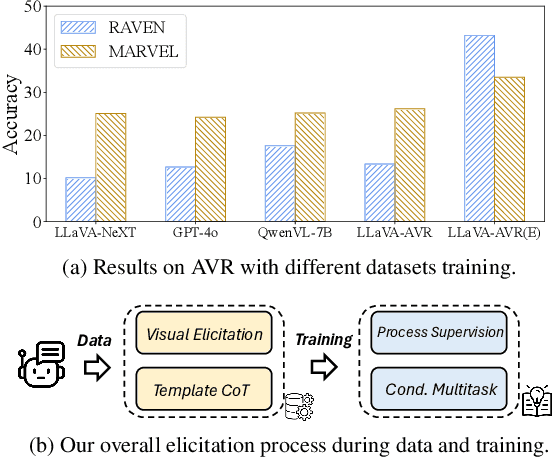



Abstract:This paper is a pioneering work attempting to address abstract visual reasoning (AVR) problems for large vision-language models (VLMs). We make a common LLaVA-NeXT 7B model capable of perceiving and reasoning about specific AVR problems, surpassing both open-sourced (e.g., Qwen-2-VL-72B) and closed-sourced powerful VLMs (e.g., GPT-4o) with significant margin. This is a great breakthrough since almost all previous VLMs fail or show nearly random performance on representative AVR benchmarks. Our key success is our innovative data synthesis and post-training process, aiming to fully relieve the task difficulty and elicit the model to learn, step by step. Our 7B model is also shown to be behave well on AVR without sacrificing common multimodal comprehension abilities. We hope our paper could serve as an early effort in this area and would inspire further research in abstract visual reasoning.
Descriptive Caption Enhancement with Visual Specialists for Multimodal Perception
Dec 18, 2024



Abstract:Training Large Multimodality Models (LMMs) relies on descriptive image caption that connects image and language. Existing methods either distill the caption from the LMM models or construct the captions from the internet images or by human. We propose to leverage off-the-shelf visual specialists, which were trained from annotated images initially not for image captioning, for enhancing the image caption. Our approach, named DCE, explores object low-level and fine-grained attributes (e.g., depth, emotion and fine-grained categories) and object relations (e.g., relative location and human-object-interaction (HOI)), and combine the attributes into the descriptive caption. Experiments demonstrate that such visual specialists are able to improve the performance for visual understanding tasks as well as reasoning that benefits from more accurate visual understanding. We will release the source code and the pipeline so that other visual specialists are easily combined into the pipeline. The complete source code of DCE pipeline and datasets will be available at \url{https://github.com/syp2ysy/DCE}.
All You Need in Knowledge Distillation Is a Tailored Coordinate System
Dec 12, 2024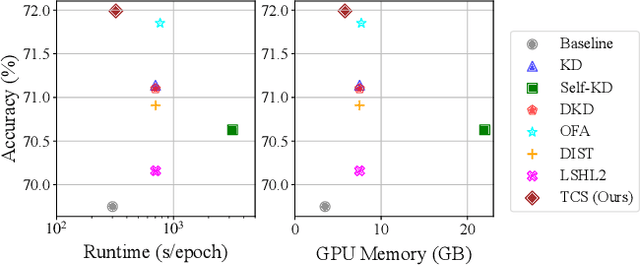

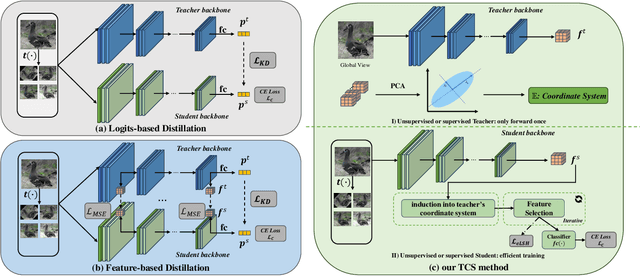
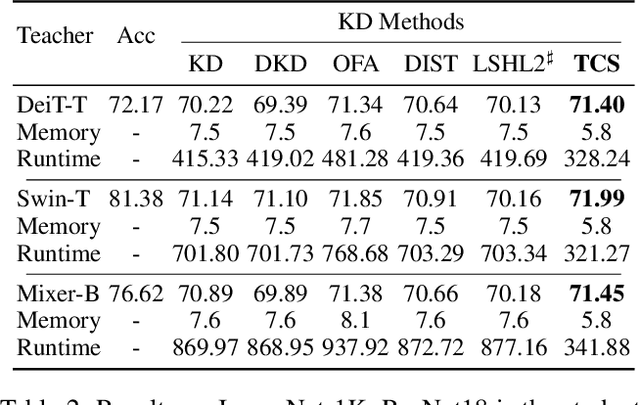
Abstract:Knowledge Distillation (KD) is essential in transferring dark knowledge from a large teacher to a small student network, such that the student can be much more efficient than the teacher but with comparable accuracy. Existing KD methods, however, rely on a large teacher trained specifically for the target task, which is both very inflexible and inefficient. In this paper, we argue that a SSL-pretrained model can effectively act as the teacher and its dark knowledge can be captured by the coordinate system or linear subspace where the features lie in. We then need only one forward pass of the teacher, and then tailor the coordinate system (TCS) for the student network. Our TCS method is teacher-free and applies to diverse architectures, works well for KD and practical few-shot learning, and allows cross-architecture distillation with large capacity gap. Experiments show that TCS achieves significantly higher accuracy than state-of-the-art KD methods, while only requiring roughly half of their training time and GPU memory costs.
Continual SFT Matches Multimodal RLHF with Negative Supervision
Nov 22, 2024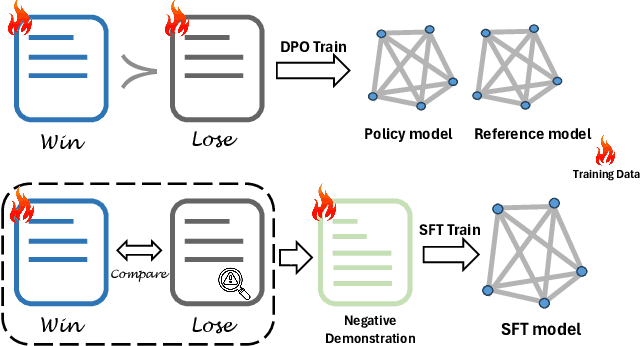
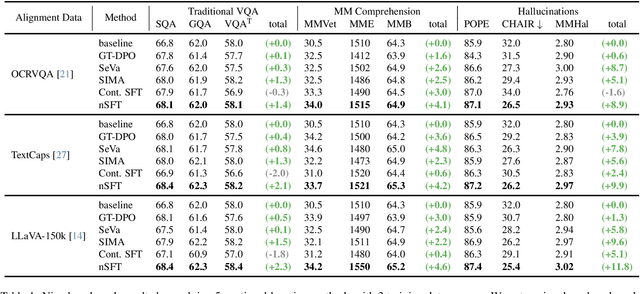


Abstract:Multimodal RLHF usually happens after supervised finetuning (SFT) stage to continually improve vision-language models' (VLMs) comprehension. Conventional wisdom holds its superiority over continual SFT during this preference alignment stage. In this paper, we observe that the inherent value of multimodal RLHF lies in its negative supervision, the logit of the rejected responses. We thus propose a novel negative supervised finetuning (nSFT) approach that fully excavates these information resided. Our nSFT disentangles this negative supervision in RLHF paradigm, and continually aligns VLMs with a simple SFT loss. This is more memory efficient than multimodal RLHF where 2 (e.g., DPO) or 4 (e.g., PPO) large VLMs are strictly required. The effectiveness of nSFT is rigorously proved by comparing it with various multimodal RLHF approaches, across different dataset sources, base VLMs and evaluation metrics. Besides, fruitful of ablations are provided to support our hypothesis. We hope this paper will stimulate further research to properly align large vision language models.
Quantization without Tears
Nov 22, 2024



Abstract:Deep neural networks, while achieving remarkable success across diverse tasks, demand significant resources, including computation, GPU memory, bandwidth, storage, and energy. Network quantization, as a standard compression and acceleration technique, reduces storage costs and enables potential inference acceleration by discretizing network weights and activations into a finite set of integer values. However, current quantization methods are often complex and sensitive, requiring extensive task-specific hyperparameters, where even a single misconfiguration can impair model performance, limiting generality across different models and tasks. In this paper, we propose Quantization without Tears (QwT), a method that simultaneously achieves quantization speed, accuracy, simplicity, and generality. The key insight of QwT is to incorporate a lightweight additional structure into the quantized network to mitigate information loss during quantization. This structure consists solely of a small set of linear layers, keeping the method simple and efficient. More importantly, it provides a closed-form solution, allowing us to improve accuracy effortlessly under 2 minutes. Extensive experiments across various vision, language, and multimodal tasks demonstrate that QwT is both highly effective and versatile. In fact, our approach offers a robust solution for network quantization that combines simplicity, accuracy, and adaptability, which provides new insights for the design of novel quantization paradigms.
Enhancement of price trend trading strategies via image-induced importance weights
Aug 16, 2024



Abstract:We open up the "black-box" to identify the predictive general price patterns in price chart images via the deep learning image analysis techniques. Our identified price patterns lead to the construction of image-induced importance (triple-I) weights, which are applied to weighted moving average the existing price trend trading signals according to their level of importance in predicting price movements. From an extensive empirical analysis on the Chinese stock market, we show that the triple-I weighting scheme can significantly enhance the price trend trading signals for proposing portfolios, with a thoughtful robustness study in terms of network specifications, image structures, and stock sizes. Moreover, we demonstrate that the triple-I weighting scheme is able to propose long-term portfolios from a time-scale transfer learning, enhance the news-based trading strategies through a non-technical transfer learning, and increase the overall strength of numerous trading rules for portfolio selection.
Generalized Maximum Likelihood Estimation for Perspective-n-Point Problem
Aug 04, 2024Abstract:The Perspective-n-Point (PnP) problem has been widely studied in the literature and applied in various vision-based pose estimation scenarios. However, existing methods ignore the anisotropy uncertainty of observations, as demonstrated in several real-world datasets in this paper. This oversight may lead to suboptimal and inaccurate estimation, particularly in the presence of noisy observations. To this end, we propose a generalized maximum likelihood PnP solver, named GMLPnP, that minimizes the determinant criterion by iterating the GLS procedure to estimate the pose and uncertainty simultaneously. Further, the proposed method is decoupled from the camera model. Results of synthetic and real experiments show that our method achieves better accuracy in common pose estimation scenarios, GMLPnP improves rotation/translation accuracy by 4.7%/2.0% on TUM-RGBD and 18.6%/18.4% on KITTI-360 dataset compared to the best baseline. It is more accurate under very noisy observations in a vision-based UAV localization task, outperforming the best baseline by 34.4% in translation estimation accuracy.
Iterative Data Augmentation with Large Language Models for Aspect-based Sentiment Analysis
Jun 29, 2024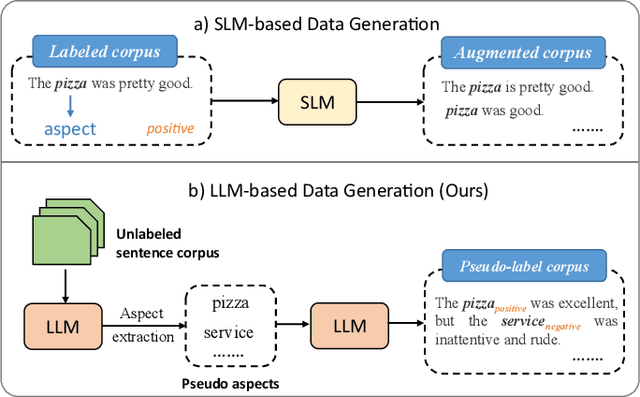
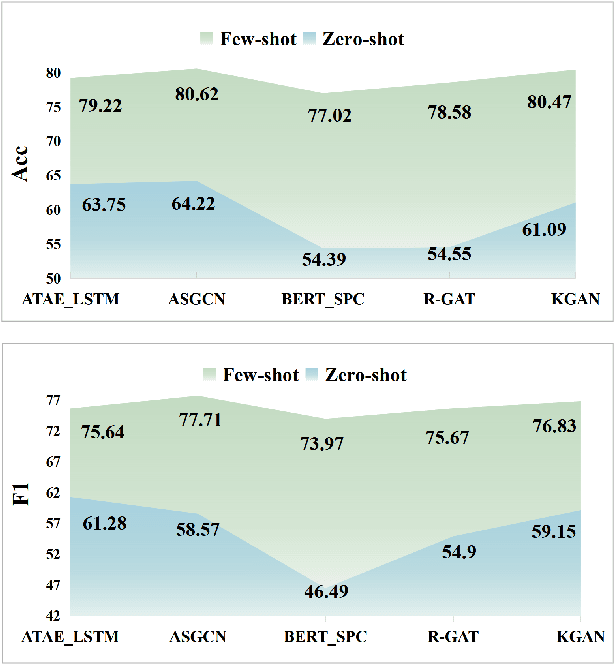
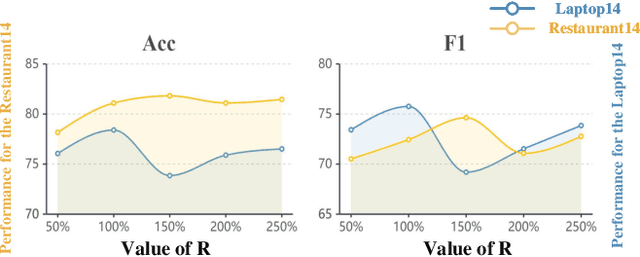
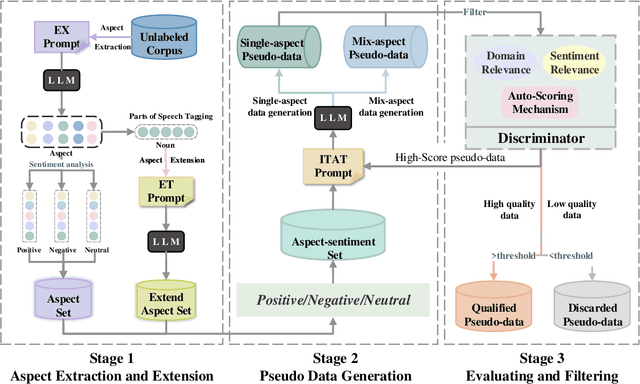
Abstract:Aspect-based Sentiment Analysis (ABSA) is an important sentiment analysis task, which aims to determine the sentiment polarity towards an aspect in a sentence. Due to the expensive and limited labeled data, data augmentation (DA) has become the standard for improving the performance of ABSA. However, current DA methods usually have some shortcomings: 1) poor fluency and coherence, 2) lack of diversity of generated data, and 3) reliance on some existing labeled data, hindering its applications in real-world scenarios. In response to these problems, we propose a systematic Iterative Data augmentation framework, namely IterD, to boost the performance of ABSA. The core of IterD is to leverage the powerful ability of large language models (LLMs) to iteratively generate more fluent and diverse synthetic labeled data, starting from an unsupervised sentence corpus. Extensive experiments on 4 widely-used ABSA benchmarks show that IterD brings consistent and significant performance gains among 5 baseline ABSA models. More encouragingly, the synthetic data generated by IterD can achieve comparable or even better performance against the manually annotated data.
Self-Supervised Visual Preference Alignment
Apr 16, 2024



Abstract:This paper makes the first attempt towards unsupervised preference alignment in Vision-Language Models (VLMs). We generate chosen and rejected responses with regard to the original and augmented image pairs, and conduct preference alignment with direct preference optimization. It is based on a core idea: properly designed augmentation to the image input will induce VLM to generate false but hard negative responses, which helps the model to learn from and produce more robust and powerful answers. The whole pipeline no longer hinges on supervision from GPT4 or human involvement during alignment, and is highly efficient with few lines of code. With only 8k randomly sampled unsupervised data, it achieves 90\% relative score to GPT-4 on complex reasoning in LLaVA-Bench, and improves LLaVA-7B/13B by 6.7\%/5.6\% score on complex multi-modal benchmark MM-Vet. Visualizations shows its improved ability to align with user-intentions. A series of ablations are firmly conducted to reveal the latent mechanism of the approach, which also indicates its potential towards further scaling. Code will be available.
 Add to Chrome
Add to Chrome Add to Firefox
Add to Firefox Add to Edge
Add to Edge